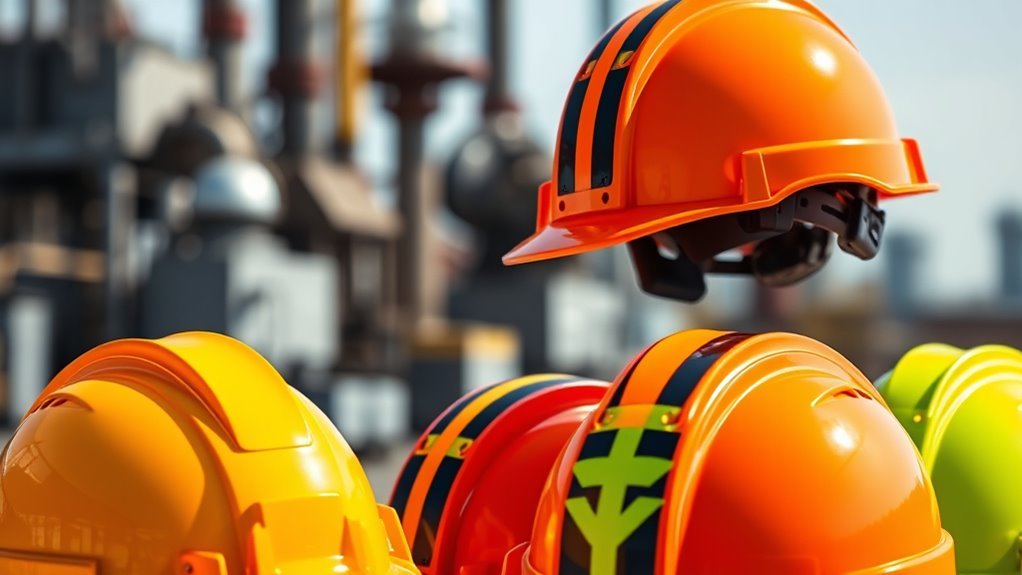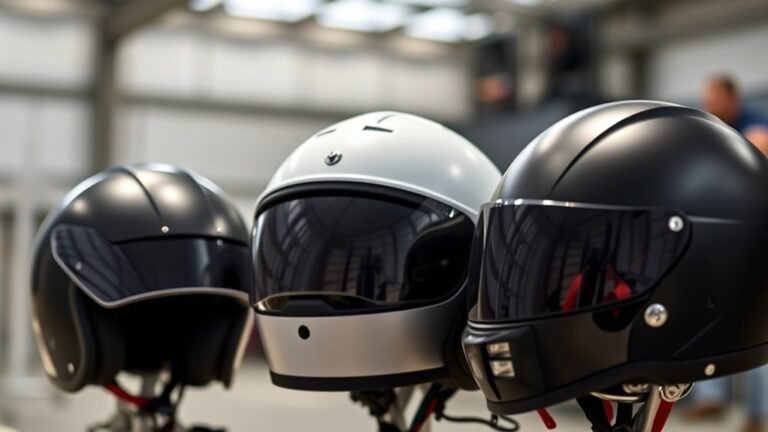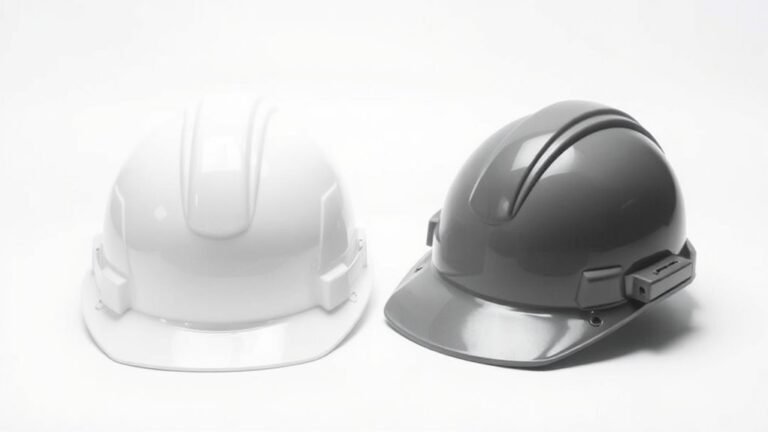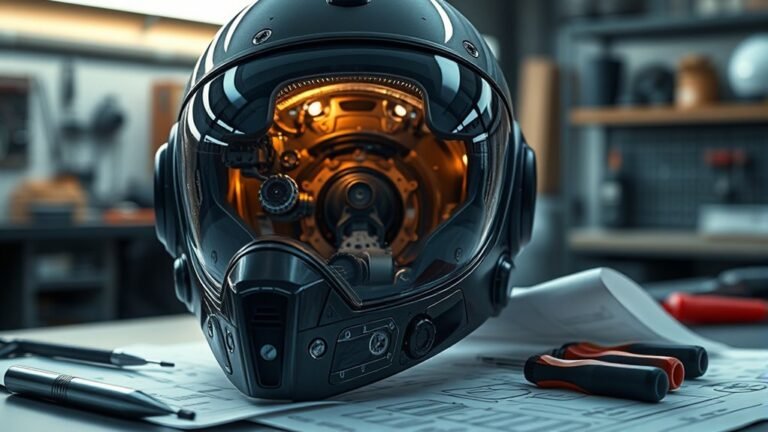Best Color Schemes for High-Visibility Helmets
When choosing high-visibility helmets, consider color schemes like yellow and black for a classic contrast, orange and white for striking visibility, or red and yellow for emergency situations. Green with reflective materials works well in outdoor settings. Custom schemes can enhance safety and reflect individual style, while regulatory standards often demand bright hues like neon yellow or orange. Explore these options to find the best fit for your needs and discover more insights on effective color choices.
Importance of High-Visibility Helmets
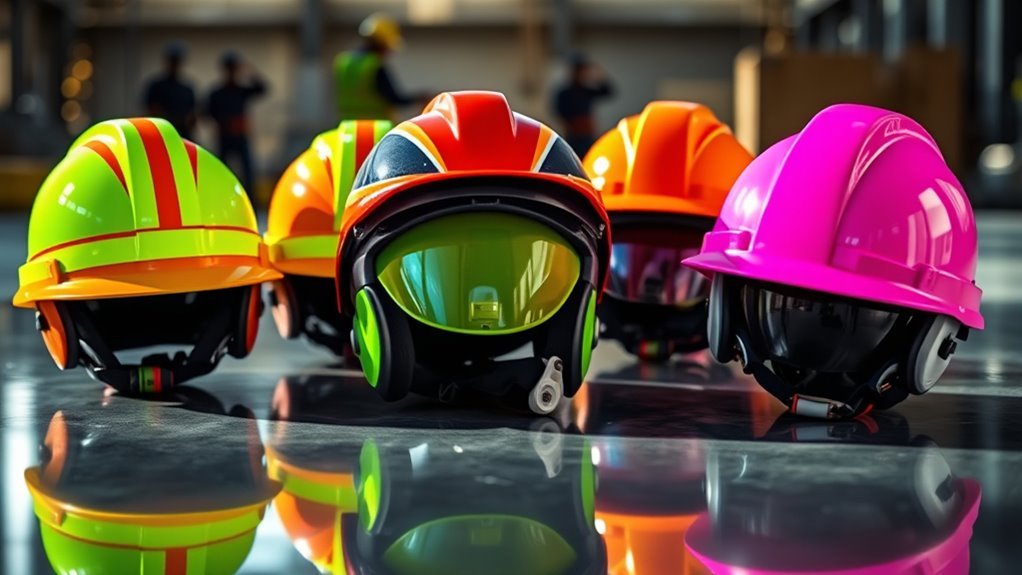
When you’re out on a job site or participating in outdoor activities, the importance of high-visibility helmets cannot be overstated. Helmet visibility plays an essential role in ensuring your safety and that of those around you. Brightly colored helmets enhance your visibility, making it easier for coworkers and equipment operators to spot you, especially in high-traffic areas. This is particularly critical in compliance with safety regulations that mandate certain visibility standards. By choosing a high-visibility helmet, you not only adhere to these regulations but also actively contribute to a safer work environment. When you prioritize helmet visibility, you embrace a proactive approach to safety, allowing you to focus on your tasks with confidence, knowing you’re protected and seen.
Yellow and Black: The Classic Combination
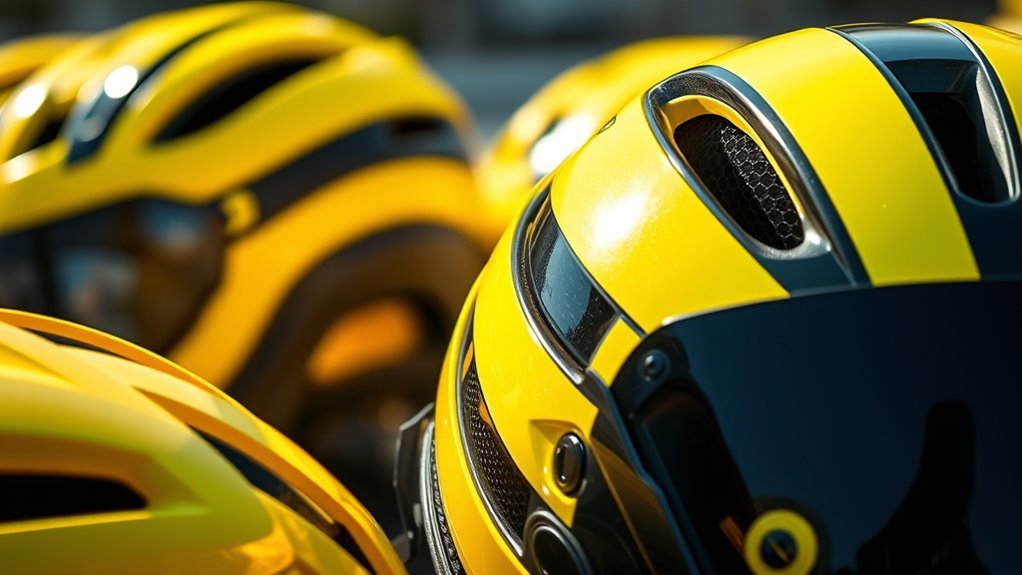
When considering helmet color schemes, the yellow and black combination stands out for both safety and aesthetic appeal. The bright yellow enhances visibility, making it easier for others to spot you in various environments, while the black adds a touch of sophistication. This classic pairing not only promotes safety but also elevates the overall design of the helmet.
Safety Visibility Benefits
Yellow and black helmets are a classic combination that greatly enhances safety visibility. This color scheme adheres to safety regulations by maximizing contrast, making you stand out in various environments. Visibility statistics show that yellow is one of the most visible colors in daylight, while black provides a striking contrast that captures attention. When you wear a helmet in these colors, you’re not just complying with regulations; you’re actively enhancing your safety. Studies indicate that high-visibility gear can reduce accident rates considerably. By choosing yellow and black, you’re choosing freedom—freedom to ride, work, or explore with confidence, knowing that others can see you clearly, even from a distance. Prioritizing visibility saves lives.
Design Aesthetic Appeal
The striking combination of yellow and black not only enhances safety visibility but also offers a compelling design aesthetic that appeals to many. This classic pairing reflects current design trends, merging functionality with style. Yellow, often associated with optimism and energy, captures attention, while black adds sophistication and depth. This interplay aligns with color psychology, where brightness evokes alertness and darkness provides contrast. When you wear a yellow and black helmet, you’re not just prioritizing safety; you’re making a bold statement about your identity. This dynamic duo suits various environments, be it urban cycling or off-road adventures, allowing you to express your freedom and individuality while remaining visible and safe. Embrace this timeless combination for both form and function.
Orange and White: A Striking Contrast
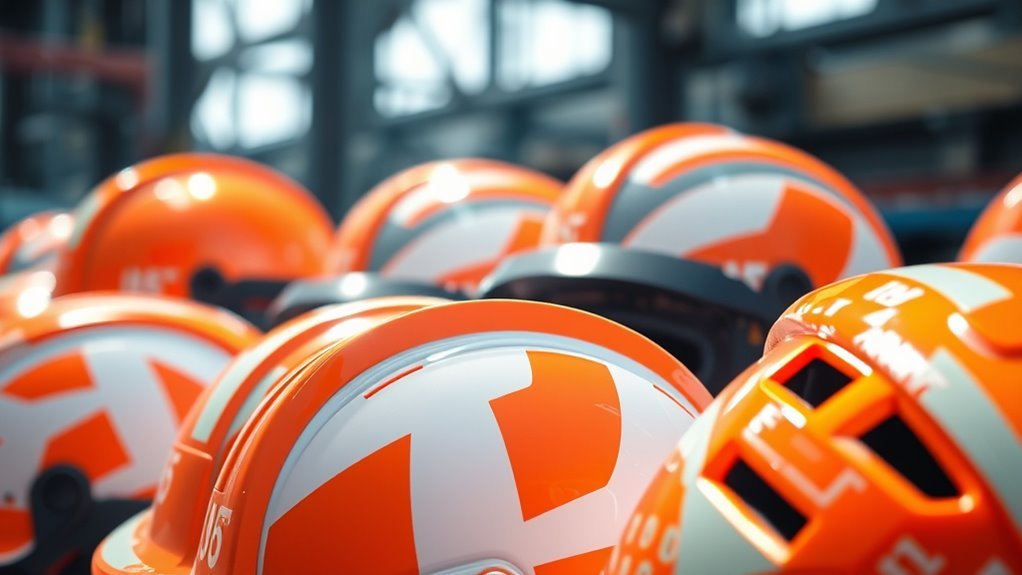
Orange and white create a visually compelling contrast that stands out in any environment, making it a popular choice for helmets across various sports and activities. The combination harnesses the energetic symbolism of orange and the illuminating brightness of white, ensuring maximum visibility.
Consider these advantages of orange and white helmets:
- High visibility: Easily spotted in various conditions.
- Bold aesthetic: Striking appearance that catches the eye.
- Psychological impact: Orange symbolizes enthusiasm and adventure.
- Safety assurance: Bright colors enhance awareness among others.
- Versatile usage: Suitable for diverse activities, from cycling to construction.
This striking contrast not only promotes safety but also embodies a spirit of freedom and adventure, appealing to those who seek to stand out.
Red and Yellow: Effective for Emergency Situations
While orange and white helmets are favored for their visibility and aesthetic appeal, red and yellow combinations serve a specific purpose in emergency situations. These colors are highly effective for emergency response personnel, offering both visibility enhancement and immediate recognition in chaotic environments. The bright red grabs attention quickly, while yellow provides a contrasting backdrop, ensuring your helmet stands out even in low-light conditions. This color scheme is essential for signaling urgency, which can save lives in critical scenarios. By adopting red and yellow helmets, you’re not just increasing your own safety; you’re also promoting a swift response from others. In emergencies, every second counts, and the right colors can make all the difference.
Green and Reflective: Ideal for Environmental Work
Green and reflective helmets are increasingly recognized as the ideal choice for professionals engaged in environmental work. Their vibrant color not only stands out in natural settings but also enhances environmental safety. Here’s why they’re essential:
- Visibility: Green stands out against foliage and landscapes.
- Reflective Materials: Enhance visibility during low-light conditions.
- Durability: Designed to withstand outdoor elements.
- Comfort: Often lightweight and breathable for long hours.
- Sustainability: Many options use eco-friendly materials.
Incorporating these helmets into your safety gear guarantees you remain visible while working in potentially hazardous environments. By choosing green and reflective helmets, you’re not just prioritizing your own safety, but also setting a standard for environmental responsibility in your field.
Blue and Neon: A Fresh Approach to Visibility
When considering helmet colors, blue and neon offer eye-catching contrast that markedly enhances visibility in various environments. The psychological impact of these colors can boost alertness and focus, essential for safety in high-risk situations. Additionally, their practical applications in safety gear make them a compelling choice for those prioritizing both style and protection.
Eye-Catching Contrast Benefits
One of the most effective color combinations for helmet visibility is blue paired with neon accents. This striking contrast not only enhances visual perception but also taps into color psychology, making the helmet stand out in various environments. Here are some benefits of this eye-catching contrast:
- Increased Visibility: The neon accents draw attention, especially in low-light conditions.
- Distinctiveness: Blue provides a calming backdrop, while neon energizes the overall look.
- Psychological Impact: Neon colors can evoke alertness and awareness.
- Versatility: This combination works well in urban and natural settings.
- Fashionable Appeal: It’s a fresh, modern choice that appeals to a wide audience.
Choosing blue and neon can greatly boost your safety while ensuring you look great.
Psychological Impact of Colors
Color psychology plays an essential role in how we perceive and respond to our surroundings, particularly in safety gear like helmets. Different colors evoke specific emotional responses and can influence our behavior and decision-making. For example, blue is often associated with calmness and trustworthiness, making it a suitable choice for helmets aimed at promoting safety and reliability. Conversely, neon colors, like vibrant yellow or green, are linked to alertness and energy, enhancing visibility and drawing attention. These color associations not only help you stand out but can also impact your mood and confidence while wearing the gear. By understanding these psychological effects, you can make informed choices about color schemes that align with your safety needs and personal expression.
Practical Applications in Safety
While choosing a helmet, considering visibility is essential for safety, especially in environments with low light or high traffic. Adopting blue and neon colors can greatly enhance your helmet’s visibility, aligning with safety protocols and industry standards. Here are key applications to keep in mind:
- Construction Sites: Bright colors stand out against machinery.
- Biking: Neon shades improve visibility to motorists.
- Emergency Services: High-visibility colors guarantee you’re seen.
- Nighttime Activities: Reflective elements paired with neon work wonders.
- Sports Events: Distinct colors help in crowd control and safety.
Custom Color Schemes: Tailoring to Specific Needs
When it comes to customizing helmets, understanding the specific needs of the user is paramount. You might want to reflect on how your environment and activities influence your color choices. Custom designs can enhance visibility and reflect your personality or team spirit. Personalized patterns, whether for a motocross event or construction site, allow you to express creativity while maintaining safety. Think about the significance of colors; bright hues can improve recognition, while unique patterns might aid in team identification. It’s crucial to blend functionality with individuality, ensuring your helmet stands out but remains practical. Tailoring your helmet’s color scheme not only fulfills safety requirements but also empowers you to embrace your style without compromising on visibility.
Regulatory Standards for High-Visibility Colors
Understanding regulatory standards for high-visibility colors is essential for ensuring both safety and compliance in various environments. You should be aware of the following key aspects related to visibility regulations:
- Color perception affects how well others see you.
- Standards vary by industry, from construction to cycling.
- Bright colors like neon yellow and orange are commonly mandated.
- Reflective materials may be required for low-light conditions.
- Compliance can reduce accident rates and enhance overall safety.
Frequently Asked Questions
How Do Weather Conditions Affect Helmet Visibility?
Weather conditions greatly impact helmet visibility factors. Rain, fog, and snow can reduce visibility, making it harder for others to see you. Bright sunlight might create glare, obscuring your helmet’s color. Conversely, overcast skies can dull colors, lessening contrast against the environment. To guarantee ideal visibility, consider these weather effects when choosing your helmet’s color. Being proactive about visibility in varying conditions enhances your safety and freedom while riding.
Are There Specific Colors for Night Use?
For nighttime safety, specific colors like white, yellow, and orange are essential, but reflective coatings greatly enhance visibility. These colors stand out in low light, while reflective materials bounce light from headlights, making you more noticeable. When choosing a helmet, consider options with high-contrast colors paired with reflective elements. This combination not only improves your visibility but also helps guarantee your freedom to navigate safely in the dark.
Can Color Schemes Impact Helmet Durability?
Yes, color schemes can impact helmet durability. If you choose vibrant colors, you might enjoy eye-catching aesthetics, but they can lead to color fading over time, especially with sun exposure. In contrast, darker colors often maintain their integrity longer. The type of paint used can also affect impact resistance; some coatings might weaken the material beneath. Ultimately, balancing style with functionality is key to ensuring your helmet remains both visible and durable.
What Materials Enhance Color Visibility?
To enhance color visibility, you should consider using helmets that incorporate reflective materials and bright pigments. Reflective materials, like retroreflective tape, increase visibility in low-light conditions, bouncing light back to its source. Bright pigments, such as neon colors, stand out against various backgrounds, making it easier for others to see you. Combining these elements not only improves safety but also guarantees you maintain a sense of freedom while being visible on the road.
How Often Should I Replace My High-Visibility Helmet?
You should generally consider a helmet’s replacement frequency every three to five years, regardless of its condition. Safety standards suggest that even minor impacts can compromise a helmet’s integrity, making timely replacements essential for maximum protection. Pay attention to signs of wear, such as cracks or fading colors. Remember, maintaining your helmet’s visibility is important, so don’t hesitate to replace it when necessary to guarantee your safety remains a top priority.
